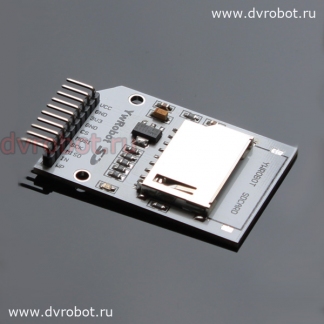





Модуль CD CARD (ID:182)
Написано
admin
,
31 May 2015
·
2653 Просмотров
 Модуль позволяет использовать CD карты совместно с Arduino, увеличивая тем самым рабочую память. Показания счетчиков и датчиков, графические файлы, музыку теперь можно смело записывать на CD карту. Для удобства работы с различными платами Arduino модуль может использовать напряжения питания либо 3,3 Вольт, либо 5 Вольт.
Модуль позволяет использовать CD карты совместно с Arduino, увеличивая тем самым рабочую память. Показания счетчиков и датчиков, графические файлы, музыку теперь можно смело записывать на CD карту. Для удобства работы с различными платами Arduino модуль может использовать напряжения питания либо 3,3 Вольт, либо 5 Вольт.Подключение к платам Arduino Uno/Duemilanove/Diecimila:
VCC - подключение напряжения питания +5 Вольт.
GND - подключение общего провода.
CS - подключение к выводу 4 платы Arduino.
MOSI - подключение к выводу 11 платы Arduino.
SCK - подключение к выводу 13 платы Arduino.
MISO - подключение к выводу 12 платы Arduino.
Ниже приведен скетч, который выводит в окно монитора порта полную информацию о карте - ее размер, тип файловой системы, список папок и файлов.
#include <SD.h>
// set up variables using the SD utility library functions:
Sd2Card card;
SdVolume volume;
SdFile root;
// change this to match your SD shield or module;
// Arduino Ethernet shield: pin 4
// Adafruit SD shields and modules: pin 10
// Sparkfun SD shield: pin 8
const int chipSelect = 4;
void setup()
{
// Open serial communications and wait for port to open:
Serial.begin(9600);
while (!Serial) {
; // wait for serial port to connect. Needed for Leonardo only
}
Serial.print("\nInitializing SD card...");
// On the Ethernet Shield, CS is pin 4. It's set as an output by default.
// Note that even if it's not used as the CS pin, the hardware SS pin
// (10 on most Arduino boards, 53 on the Mega) must be left as an output
// or the SD library functions will not work.
pinMode(10, OUTPUT); // change this to 53 on a mega
// we'll use the initialization code from the utility libraries
// since we're just testing if the card is working!
if (!card.init(SPI_HALF_SPEED, chipSelect)) {
Serial.println("initialization failed. Things to check:");
Serial.println("* is a card is inserted?");
Serial.println("* Is your wiring correct?");
Serial.println("* did you change the chipSelect pin to match your shield or module?");
return;
} else {
Serial.println("Wiring is correct and a card is present.");
}
// print the type of card
Serial.print("\nCard type: ");
switch(card.type()) {
case SD_CARD_TYPE_SD1:
Serial.println("SD1");
break;
case SD_CARD_TYPE_SD2:
Serial.println("SD2");
break;
case SD_CARD_TYPE_SDHC:
Serial.println("SDHC");
break;
default:
Serial.println("Unknown");
}
// Now we will try to open the 'volume'/'partition' - it should be FAT16 or FAT32
if (!volume.init(card)) {
Serial.println("Could not find FAT16/FAT32 partition.\nMake sure you've formatted the card");
return;
}
// print the type and size of the first FAT-type volume
uint32_t volumesize;
Serial.print("\nVolume type is FAT");
Serial.println(volume.fatType(), DEC);
Serial.println();
volumesize = volume.blocksPerCluster(); // clusters are collections of blocks
volumesize *= volume.clusterCount(); // we'll have a lot of clusters
volumesize *= 512; // SD card blocks are always 512 bytes
Serial.print("Volume size (bytes): ");
Serial.println(volumesize);
Serial.print("Volume size (Kbytes): ");
volumesize /= 1024;
Serial.println(volumesize);
Serial.print("Volume size (Mbytes): ");
volumesize /= 1024;
Serial.println(volumesize);
Serial.println("\nFiles found on the card (name, date and size in bytes): ");
root.openRoot(volume);
// list all files in the card with date and size
root.ls(LS_R | LS_DATE | LS_SIZE);
}
void loop(void) {
}После загрузки скетча включите монитор порта. Вы должны увидеть примерно следующее: 
Ссылка на витрину магазина http://dvrobot.ru/238/384.html.













